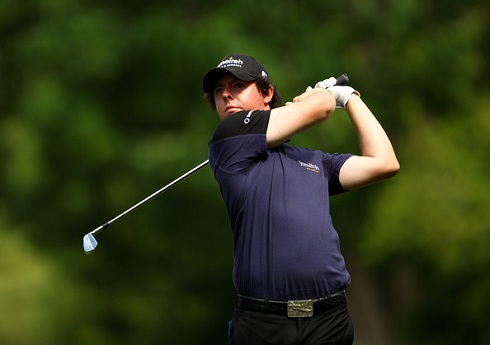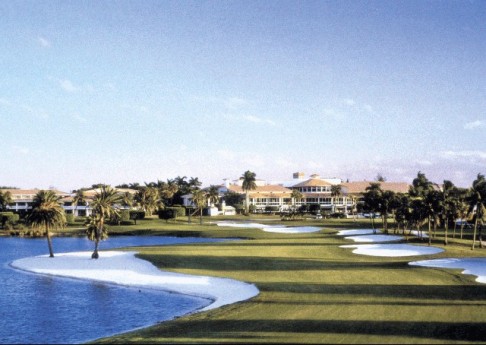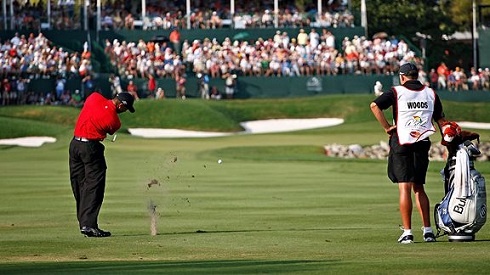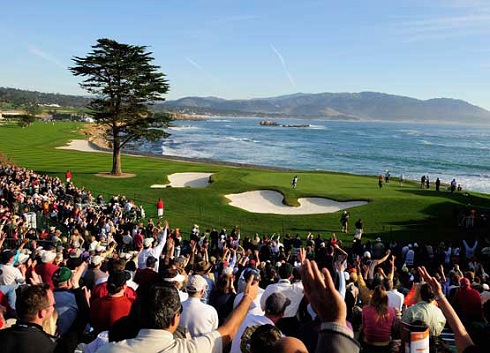 The 18th hole can make or break your round. It’s where you finish off your opponent, come from behind, or claim the trophy. When the leaderboard is crowded it can be the most stressful hole in golf, but with a big advantage it’s a time to bask in the glories of victory, the one and only time you will ever see a professional golfer take off his hat and stride towards the green, arms waving in acknowledgement of crowd.
The 18th hole can make or break your round. It’s where you finish off your opponent, come from behind, or claim the trophy. When the leaderboard is crowded it can be the most stressful hole in golf, but with a big advantage it’s a time to bask in the glories of victory, the one and only time you will ever see a professional golfer take off his hat and stride towards the green, arms waving in acknowledgement of crowd.
The best 18th holes combine risk and reward, and are the crown jewels of the course that architects dream about. You want to leave the golfer with a good taste in their mouths, because 17 lackluster holes can be forgotten thanks to one great one (which is probably why I always seen to hit the fairway on the last hole when I’ve played an entire crappy round). You want to offer the golfer a chance to make a birdie (or even an eagle), but you also want to punish bad shots, and make double bogey possible as well. On the PGA Tour this is all the more important, as multi-million dollar tournaments typically come down to the 72nd hole.
Number Five: Quail Hollow Club
We start off with a 478 yard par-four, the 18th hole at Quail Hollow Club. Though the tournament now known as the Wells Fargo Championship has only been around since 2003, it has accumulated quite a reputation, much of which is due to its finishing hole. The third leg of the Green Mile is long and narrow and dog-legs slightly to the right. A bunker guards the right side of the landing area and a sneaky little creek runs alone the entire left side of the hole.

That meandering creek sees a lot of action, as Dustin Johnson found out this year when he finished a tough Friday with two balls in the water, landing a snowman on his scorecard and giving him a 79 for the round. Back in 2003, David Toms came to the 72nd hole up five strokes, and limped into the scorer’s tent clinging onto a one-shot lead after he too carded an eight. On the other hand, last year Rory McIlroy drained a 50-footer on the 18th sloping green to cap off his spectacular round of 62 and to win his only PGA Tour tournament prior to the 2011 U.S. Open.
Number Four: TPC Blue Monster at Doral
We move next to the 18th at Doral. The finishing hole at the Blue Monster fits the same mold cast by the first 17 holes, only for this one course designer Dick Wilson turned it up to 11. It consistently ranks among the toughest holes on the PGA Tour and, as the last hole on the golf course, it almost always decides the winner.
Doral got it’s name “The Blue Monster” when, during the inaugural year of the tournament, the head pro said of the 18th, it’s “a monster… a blue monster,” after it played more than an entire stroke over par for the week. On paper, it’s laid out in front of you. Left is dead. Right puts you in increasingly thick rough among a bunch of palm trees. Out of rough that thick, it’s pretty easy to let the club snag in the turf and roll over, pulling the ball weakly into the water. You need to hit it the right distance, too. On a green that sloped, you don’t want to be hitting a long iron, so it’s mighty tempting to pull the driver.

Number Three: Torrey Pines South Course
The 18th hole at the Torrey Pines South Course is another hole hole cut from the fabric of the previous 17 before it. It’s 571 yards at its farthest, not exactly a monster, but it has several intricate nuances that make this a great closing hole. The 18th at Torrey won’t sneak up on you. It’s pretty straightforward, but sometimes straightforward will eat you up. The first nuance is just the fact that it’s a par 5. Because you can make an eagle or a triple bogey, huge swings are possible on just one hole. Two combatants coming down the final fairway on Sunday can be separated by a wide margin and come out tied or even flip-flopped. With that pond in the front of the green, no lead is safe.
From the tee box, your first objective is to hit the fairway. If you don’t, say goodbye to an eagle chance. With two bunkers guarding a landing area no wider than a five-iron, landing a golf ball there is easier said than done. From the fairway, the question is “Where do you want to lay up to?” You can hit the easy second shot short of the water, and play for a full short iron into the green, or you can go after it a little bit more and hit it right of the water, which gives you an easier and shorter second shot that steers clear of most of the risk.
Of course, you also have to option to go for it. Most people will be perfectly content with a ball in the rough over the green or in the sand left or right, but there is no easy shot around this green. If you’re long you have to stand over the ball knowing that the water is looming just on the other side of the green. The green itself is also nothing to scoff at. It is huge tract of land divided into four quadrants, and crossing from one section to another is a real test of green reading and speed guessing.
Number Two: Bay Hill Club and Lodge
The finishing hole at Bay Hill is one of the best in golf, and easily the best and most memorable hole on the golf course. It’s a beautiful design, with water short and right of the green and three bunkers long. Off the tee you need to keep the ball to the left, which provides a better angle to the green, especially to the Sunday pin position. At 458 yards, a straight and long drive is a must. When you are in that rough the water looks as big as an ocean, so expect to have the urge to bailout left. Even that is no easy task though, if you miss the fairway the greenside rough is plenty thick. The green slopes pretty drastically left to right and back to front but, as Tiger showed us for two straight years, putts can be made. It is Florida though, so the grain of the grass can throw some people off.

The 18th hole has been host to some of the more spectacular moments of the last few years. This year Martin Laird conquered a two putt from 90 feet to seal his victory, and last year Ernie Els got up and down from a greenside bunker to make a clutch par and win the championship. Fittingly, it was Els’ 18th win on the PGA Tour. The real action though came in 2008 and 2009, off the putter-face of Tiger Woods. Both times Tiger kept his approach shot a little over 20 feet left, and drained a birdie putt. In 2008, Tiger ripped off his hat and threw it to the ground in celebration, and in 2009 Tiger fist pumped just as the sun began to set on northern Florida. His luck wasn’t quite the same this year though, as Tiger dunked it into the water to fall out of the top 10.
Number One: Pebble Beach Golf Links
The 18th at Pebble Beach is the quintessential finishing hole. It’s beautiful. It’s the perfect collision of land and sea, bountiful with ocean life and a rich golfing history. It’s also a par five, which, like Torrey Pines, offers a unique opportunity for high and low scores.

Picture this: you’ve just finished the 17th at Pebble, a long par-three with a green the side of a thumbtack, and you need to make back the stroke you just lost after hitting into one of the deep bunkers that surrounds the green. Unfortunately, the 18th hole offers no such solace.
Off the tee you have options. Do you take out the driver, or do you lay up and play for the green in three? If you try for the long ball, again you have a decision to make. Do you try to cut the corner a bit and pipe one down the left-hand side, or do you take the safer play to the right, taking the water out of play? If you go left all that separates you and Japan is a vast ocean, a watery grave just looking to make your golf ball its next victim. One fluke gust of wind can make or break your entire round. But the right side of the hole isn’t all roses and daisies either, as several large trees blocks your second shot. If you think you can pull off a shot like Tiger did last year by bending one around the tree be my guest, but most people will likely pull a wedge and give in to the beast the is the 18th.
Many people have found that water, even pros. In 2000, when it seemed like he could do no wrong en route to a 15-stroke victory, even Tiger hooked one into Carmel Bay. Major champion John Daly made a 14 on that hole after hitting into the bay five times. He subsequently withdrew (surprise, surprise). You might get lucky though, for what the Bay takes, it also gives back. In 1984, Hale Irwin famously hit one into the bay but got lucky as the ball caromed off a boulder and into the fairway. Never one to let some good fortune go to waste, he made birdie and would win in a playoff.
Conclusion and Your Thoughts?
On the PGA Tour, it all comes down to the last hole, and with all of the playoffs we’ve had this year that’s never been more true. The 18th should make you win the tournament, rather than handing you an easy par. It should force you to make the tough decision. To bomb it or lay back, to go for it or not, to jam the ball in the hole or to die it. The 18th hole should be the culmination of a great round of golf, the architects’ one last hurrah to keep you coming back.
Photo Credits: © Chris Condon/US PGA Tour, © J.D. Cuban, © Richard Heathcote, © Doral Golf Resort and Spa.

Good choices.
The PGA tour gets off to a good start at Kapalua. The 18th on the Plantation Course is a 663yd downhill reachable par 5. Bubba Watson made it very exciting this year going driver, driver, putter for eagle.
I would not include Doral, Torrey Pines, and Bay Hill on a shortlist of great finishing holes. I hold none of those courses in particularly high esteem, and my opinion of their 18th holes are reflective of the 17 that come before them. I’d replace them, in no particular order, with:
-Harbour Town (par 4, 452 yards)
After 17 holes that wind through the pines of Hilton Head, the player is greeted on the last tee with a spectacular panorama of Calibogue Sound, with harbor and lighthouse sitting just beyond the green. The landing area for the tee shot is extremely generous, jutting out into the sound, but sets up an approach over water to a tiny green protected by deep bunkers both back and front.
-Riviera (par 4, 475 yards)
A round at Riviera begins with a dramatically-elevated tee shot, and the next 16 holes wind their way through a canyon that causes players to forget that what goes down must eventually come back up. Riviera closes with a long par 4 that is made even longer by the severe climb from tee to green; even pros stuggle to reach the plateau fairway from the tips on the cold, damp days the California wet season is known to bring during the tour’s west coast swing. The amphitheater green, set below Riviera’s palatial clubhouse, is a sight to behold, whether or not hundreds of fans are gathered on the hillside.
-East Lake (par 3, 232 yards)
One can make a strong case that the hardest hole for a top professional is the long par 3. East Lake’s 18th is a tough test for the pros to begin with; the pressure of the being the last hole of the round only makes it more difficult. Depending on one’s length, the player has anything from a fairway wood to hybrid to long iron to a green that only accepts the most perfectly-struck tee shots. As Jim Furyk proved last year, a golfer reaches the final hole of the Tour Championship with a one-shot lead and $10 million on the line, a par cannot be taken for granted.
I think that TPC PLAYERS Stadium at Sawgrass should be on this list: Par 4 462 from the tips with water all the way down the left hand side and a tight fairway. It is a demanding hole. It may not have the pacific ocean as the backdrop, but it’s a great atmosphere with the grandstands and the clubhouse in the background.
Oh and by the way, the largest purse on the Tour is on the line.